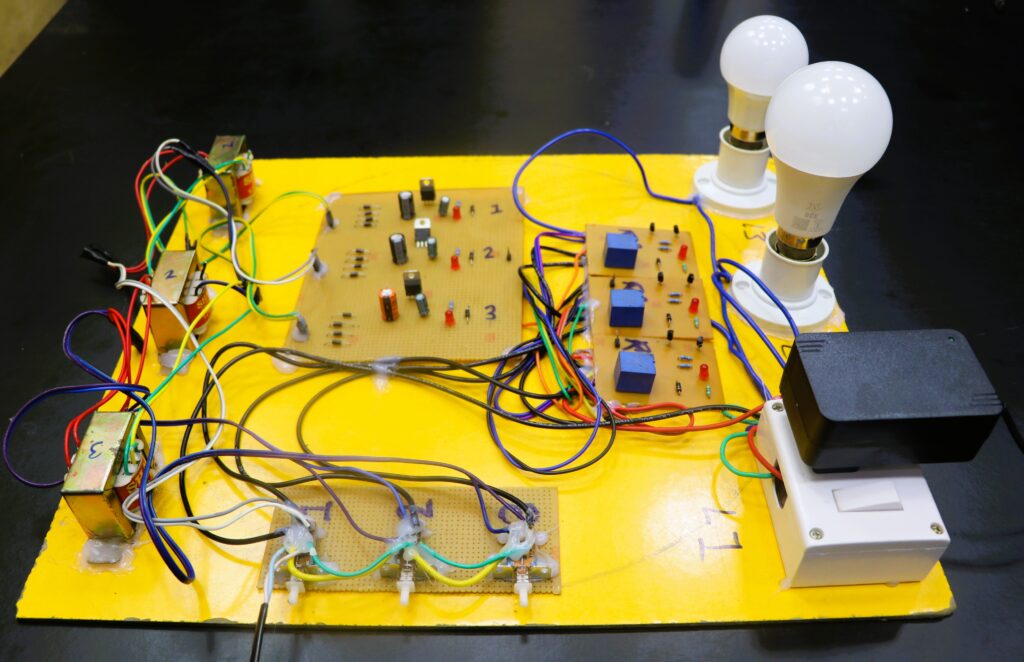Without Microcontroller Project, Without Microcontroller Kits
Automated Three-Phase Switching System | An Electrical Project
Introducing the Automated Three-Phase Switching System: A Revolutionary Solution for Power Management In today’s dynamic electrical landscape, seamless power management is crucial for ensuring the smooth operation of various appliances, machinery, and industrial equipment. Our innovative Automated Three-Phase Switching System addresses this need by providing an intelligent and efficient solution for switching between three-phase power sources. students from electrical engineering background who is pursuing B.tech, M.tech, PHD, Diploma and ITI can make this project as their college project submission. This is one of the best core electrical engineering project.
Video Demonstration:
Introduction
Power distribution is a critical component of any electrical system. In many industrial and residential setups, ensuring a continuous power supply is vital. The Automated Three-Phase Switching System addresses this need by automatically switching between phases in case of a power failure in one of the phases. This project is particularly useful in environments where power reliability is crucial.
Components Used
The success of the Automated Three-Phase Switching System hinges on the precise functioning of various components. Here is a list of the essential components used in this project:
Three Transformers: These step down the voltage from 230V to 5V.
Phase Selector Switches: These are used to select the active phase.
Three 230V to 5V Power Supplies: These provide the necessary power for the control circuit.
Three Relay Boards: These are responsible for shifting the phases.
Three AC Bulbs: These represent the loads in the system.
Microcontroller (e.g., Arduino): This acts as the brain of the system, controlling the switching mechanism.
Voltage Sensors: These monitor the voltage levels of each phase.
Connectors and Wiring: These are essential for establishing connections between components.
Working
The Automated Three-Phase Switching System operates on a straightforward principle. Here’s a step-by-step explanation of its working:
Voltage Monitoring: The voltage sensors continuously monitor the voltage levels of all three phases.
Phase Selection: When the system detects a voltage drop or failure in the active phase, the phase selector switches signal the microcontroller.
Relay Activation: The microcontroller processes the input and activates the corresponding relay to switch to an alternative phase.
Load Transfer: The load is seamlessly transferred to the selected phase, ensuring an uninterrupted power supply.
Feedback Loop: The system continuously monitors the voltage levels to maintain stability and efficiency.
Applications
The Automated Three-Phase Switching System finds applications in various fields due to its reliability and efficiency:
Industrial Plants: Ensures continuous power supply to critical machinery.
Residential Buildings: Provides a reliable power backup system.
Hospitals: Maintains uninterrupted power for essential medical equipment.
Data Centers: Ensures the stability of servers and data storage systems.
Commercial Establishments: Keeps business operations running smoothly during power fluctuations.
Advantages
The benefits of implementing the Automated Three-Phase Switching System are manifold:
Reliability: Ensures a consistent power supply, reducing downtime.
Efficiency: Optimizes power usage by switching to the most stable phase.
Cost-Effective: Reduces the need for expensive UPS systems or generators.
Automation: Minimizes human intervention, thereby reducing the chances of error.
Scalability: Can be easily scaled to suit larger power requirements.
Disadvantages
Despite its numerous advantages, the Automated Three-Phase Switching System has some limitations:
Initial Cost: The initial setup can be expensive due to the cost of components.
Complexity: The system requires precise calibration and programming.
Maintenance: Regular maintenance is needed to ensure optimal performance.
Dependency on Components: The system’s reliability depends on the quality of its components.
Future Scope
The future of the Automated Three-Phase Switching System is promising, with several potential advancements on the horizon:
Integration with Smart Grids: Enhancing the system to work seamlessly with smart grids for better efficiency.
IoT Integration: Using IoT devices for remote monitoring and control.
Improved Sensors: Developing more accurate and reliable sensors for better performance.
AI Algorithms: Implementing AI for predictive maintenance and smarter phase selection.
Conclusion
The Automated Three-Phase Switching System is a groundbreaking solution in the field of electrical engineering. Its ability to provide a reliable and efficient power supply makes it indispensable in various applications. While there are some challenges in terms of cost and complexity, the benefits far outweigh the drawbacks. As technology advances, this system is poised to become even more robust and integral to power distribution systems worldwide.

